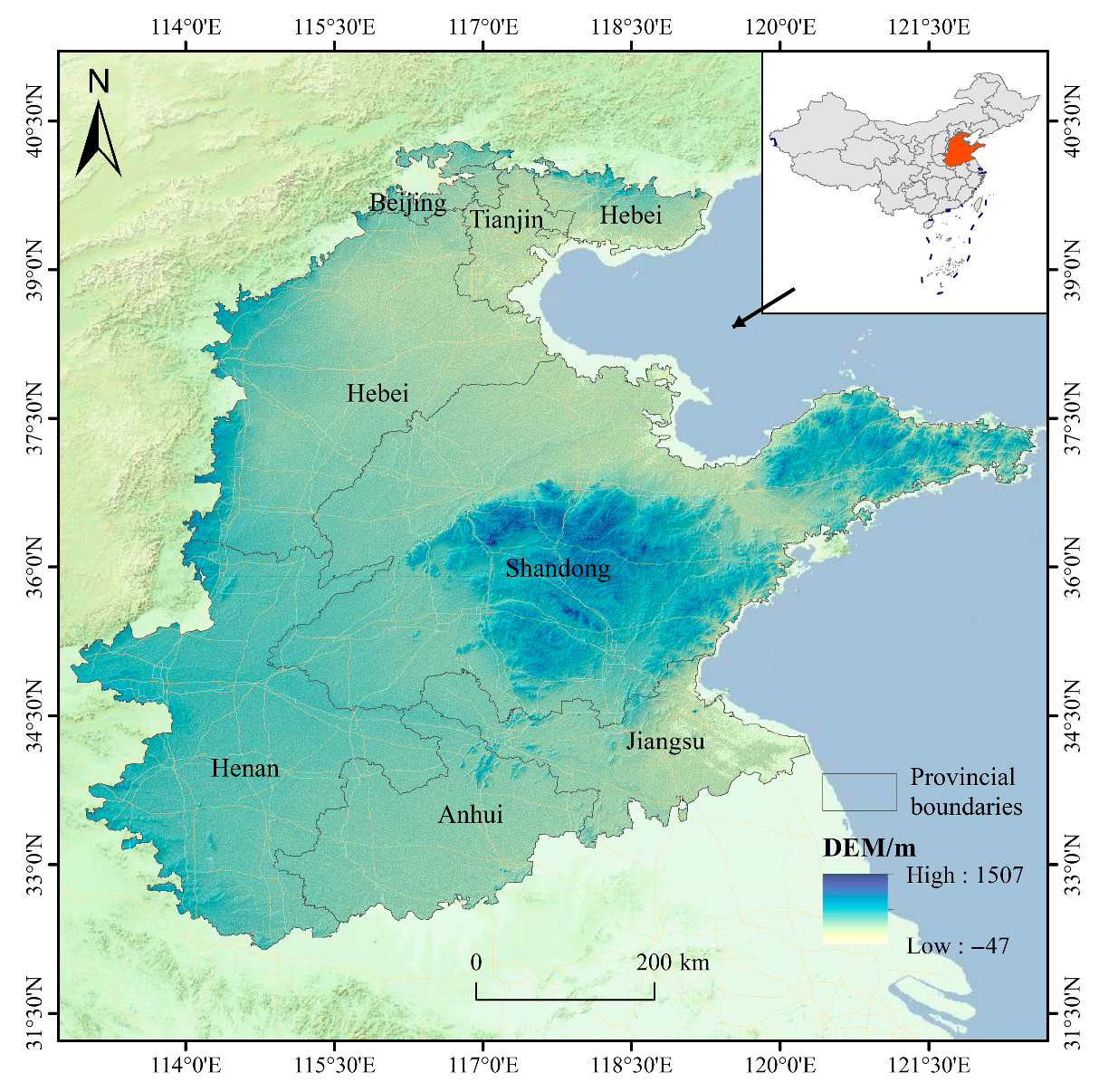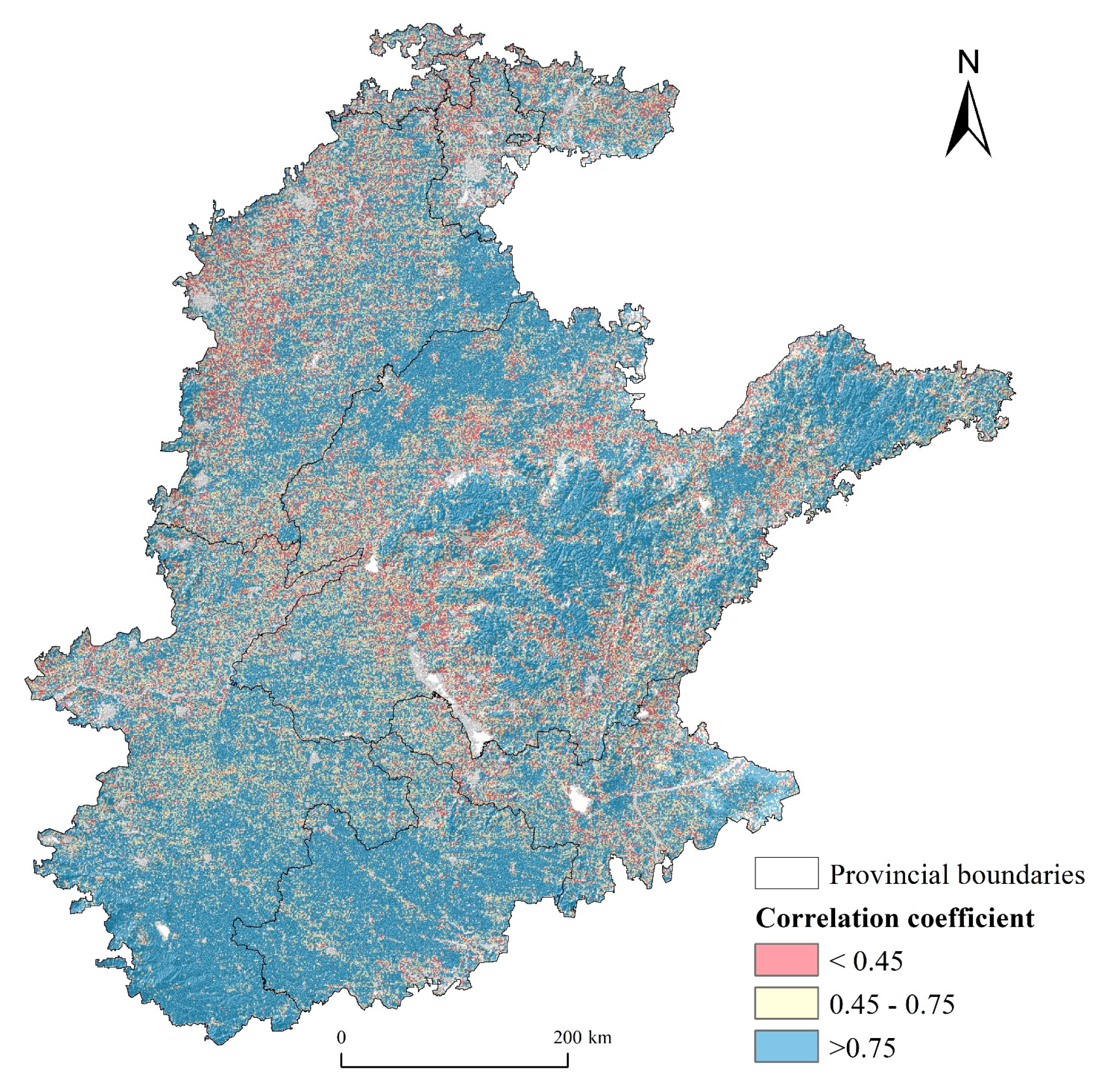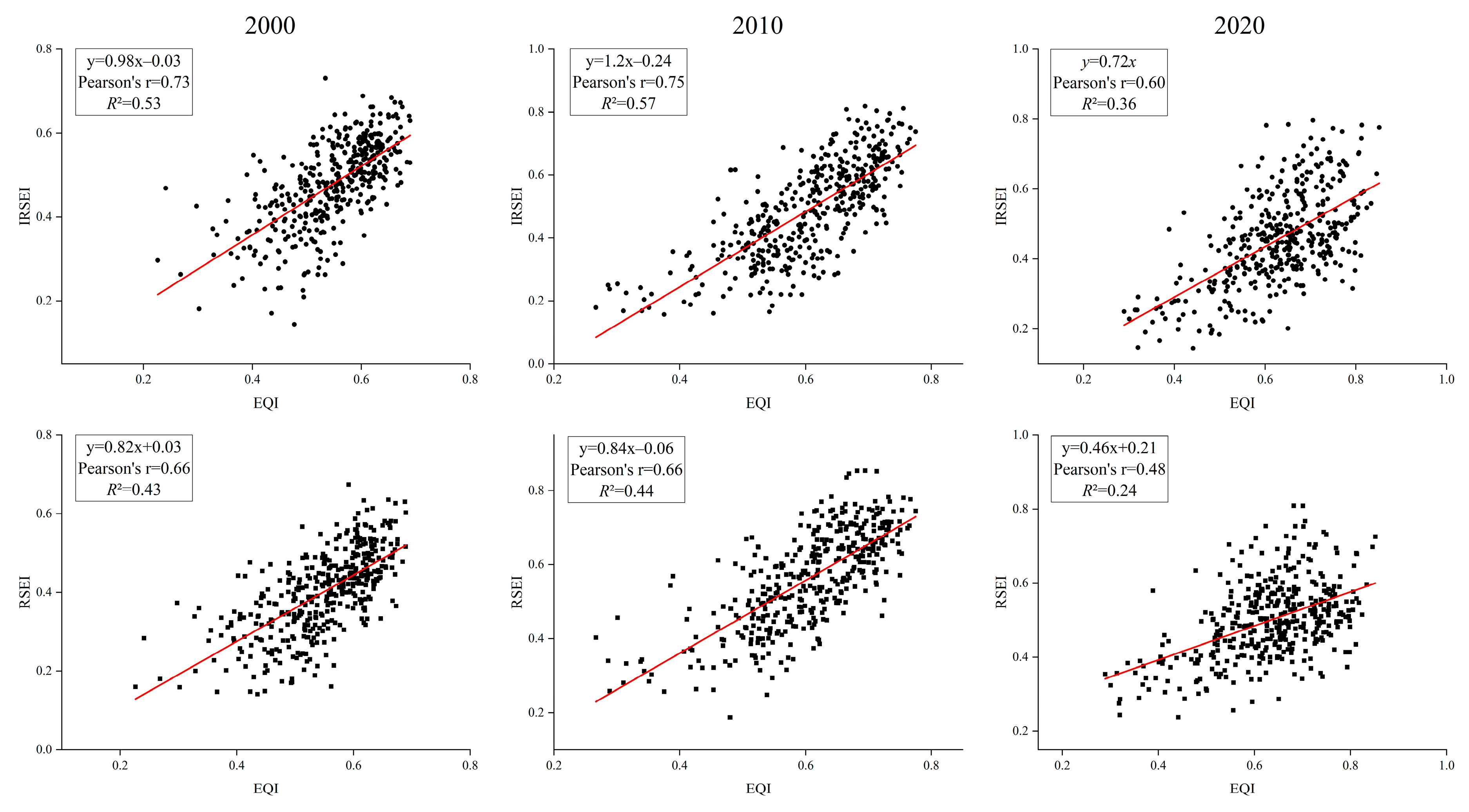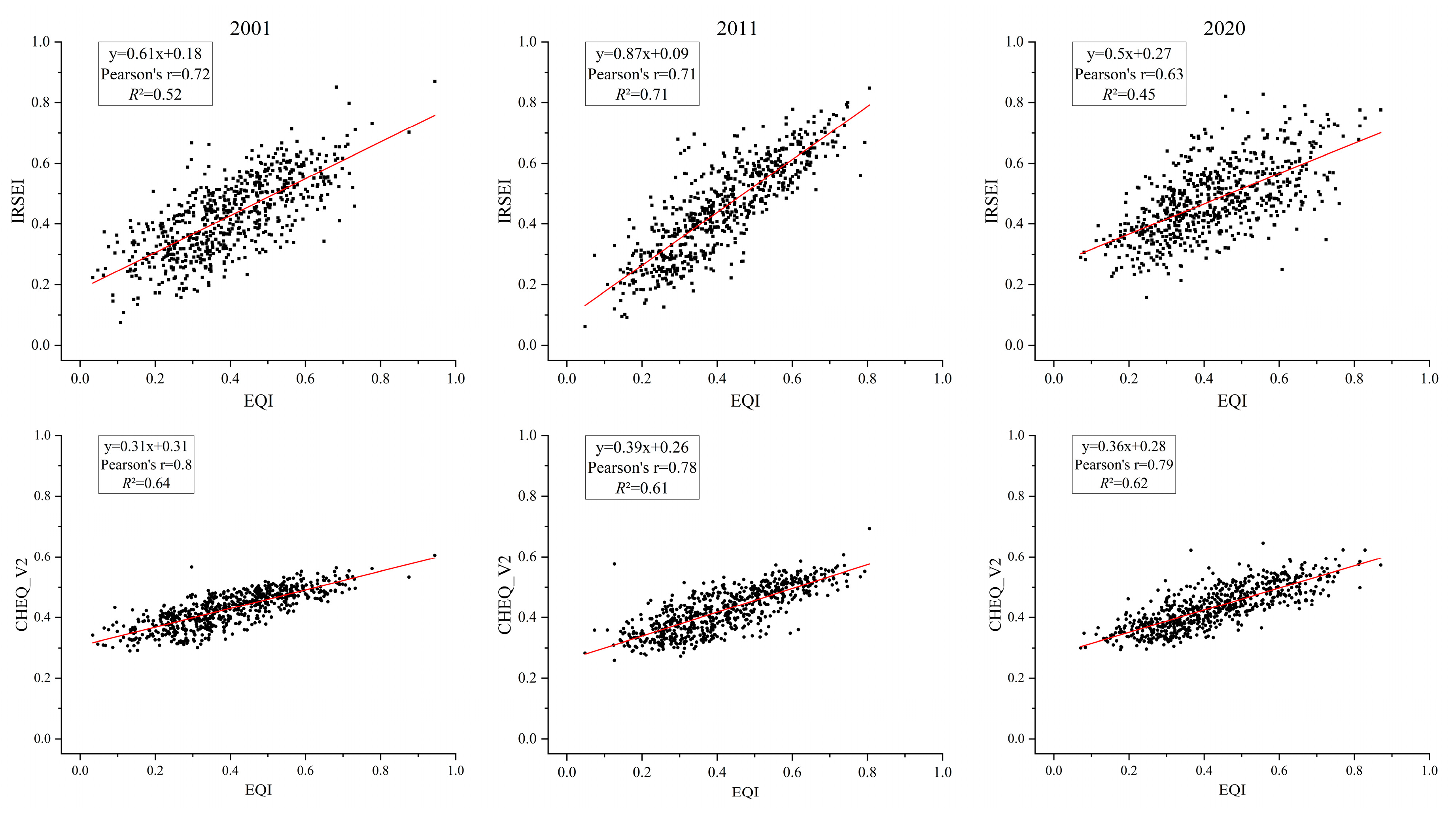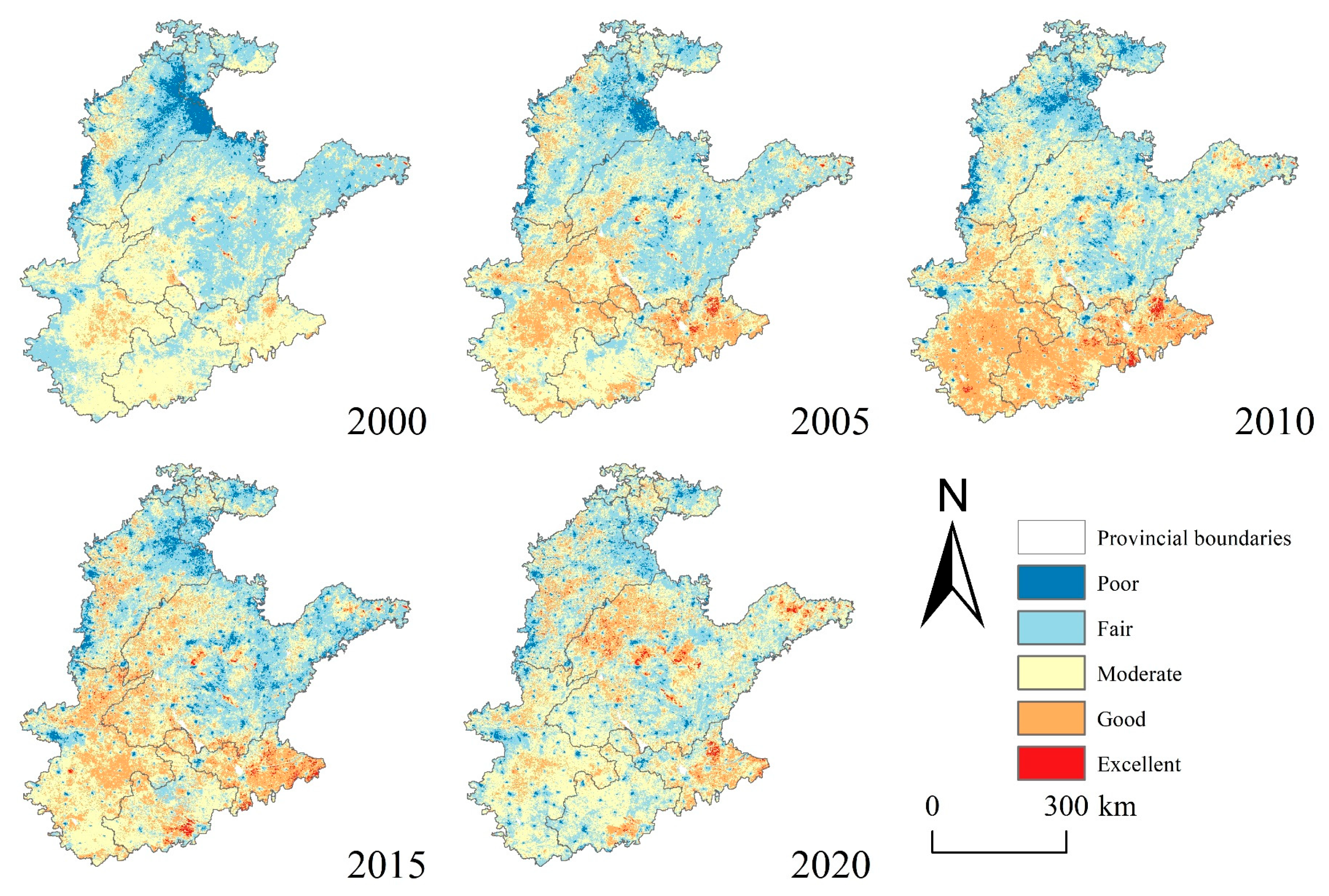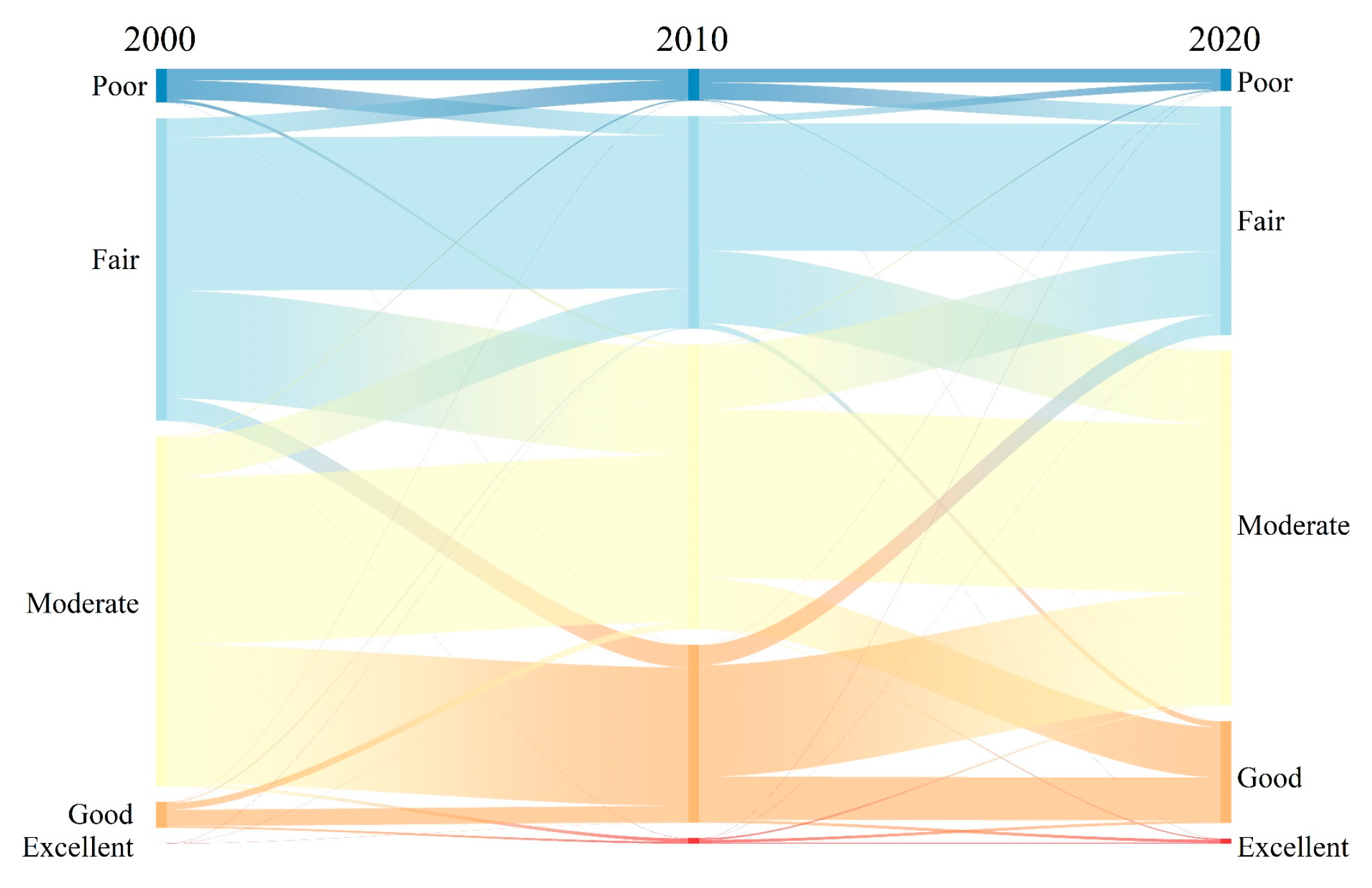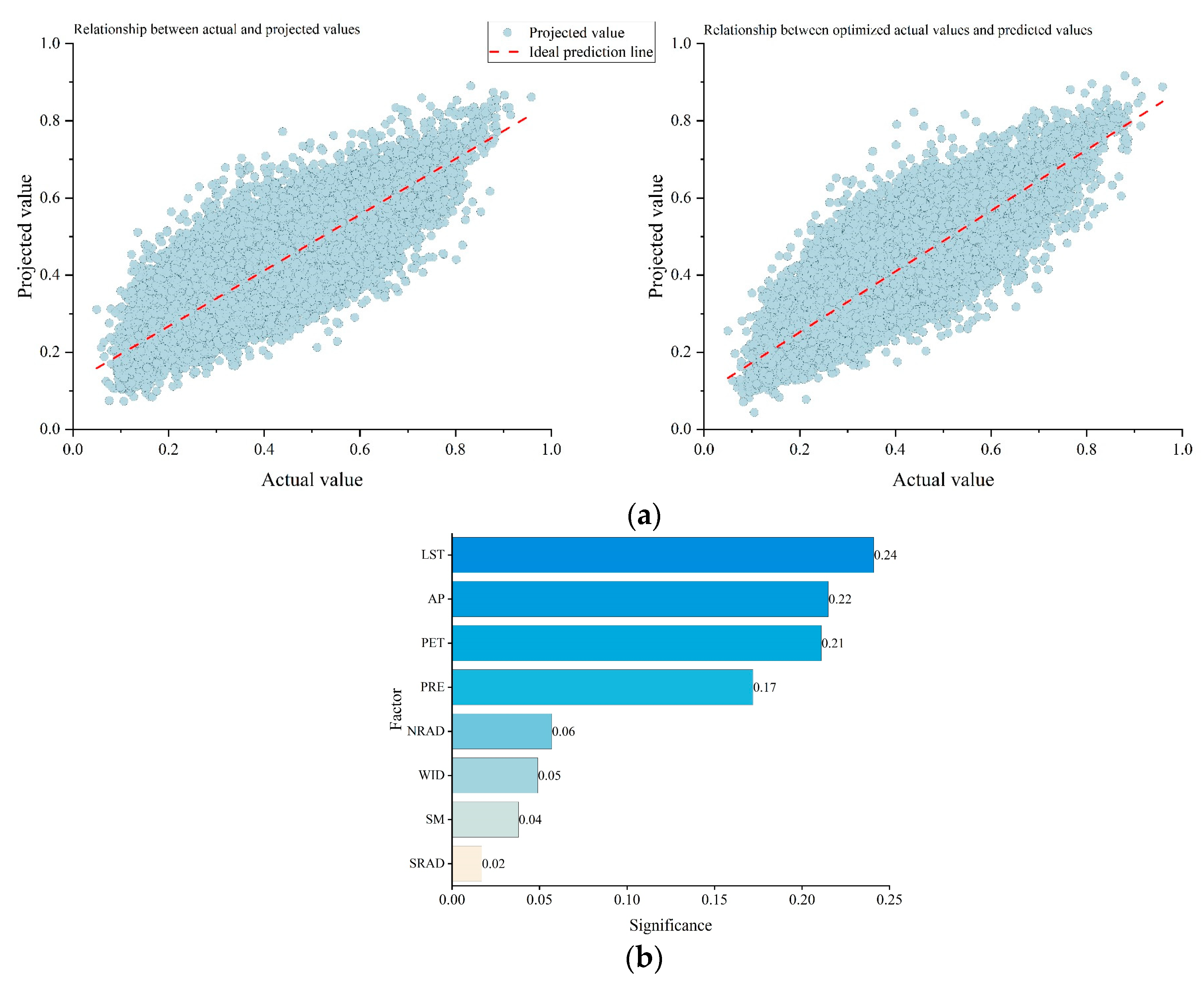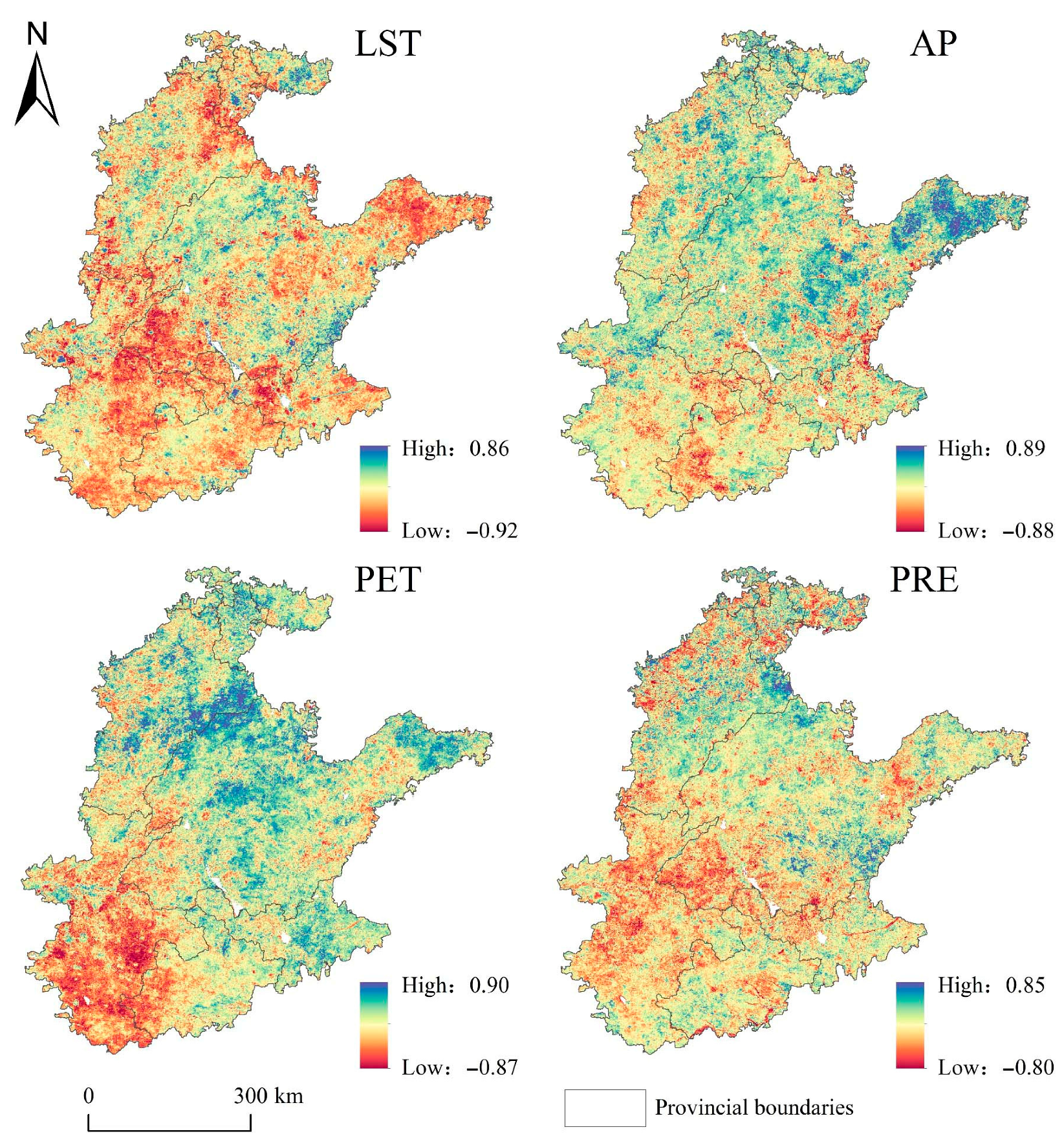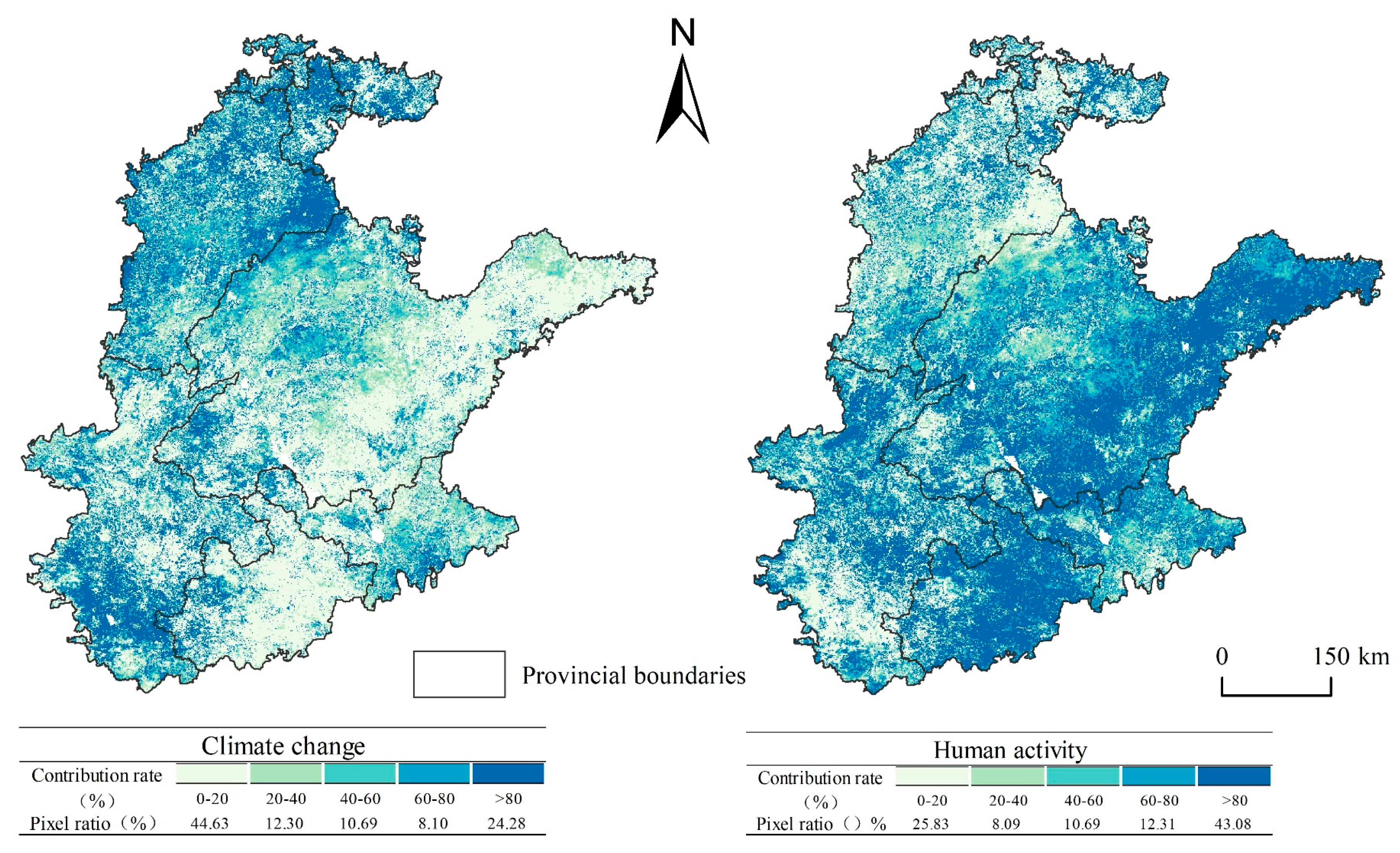1. Introduction
The North China Plain (NCP) serves as a crucial ecological barrier and economic core region in northern China [
1], playing a vital role in national food security, regional economic growth, and public well-being. As a climate-sensitive area and a pivotal link between the eastern and western regions, the ecological environment profoundly influences development patterns and the efficiency of resource allocation [
2]. A region’s rich biodiversity and vital ecosystem services are fundamental to maintaining ecological balance and promoting sustainable development [
3]. Scientifically assessing the quality of the ecological environment of the NCP is crucial for understanding the mechanisms of climate change response, optimizing resource allocation, and serving as a key pathway for ensuring food security, preserving ecological barriers, and advancing the construction of a beautiful China.
With the advancement of remote sensing technology, multisource remote sensing data, which are characterized by wide spatial coverage and long-term observations, have provided a novel technical approach for assessing the ecological environment [
4,
5]. Early assessments of ecological conditions primarily relied on single remote sensing indices [
6,
7], which, although capable of reflecting certain local ecological characteristics, failed to represent the overall regional ecological status. In response, researchers have proposed comprehensive evaluation frameworks, such as the ecological index (EI) and the pressure–state–response (PSR) model [
8,
9]. However, these methods face challenges, including data integration difficulties, subjectivity in index weighting, and limited regional adaptability. To address these issues, Xu [
10] introduced the remote sensing ecological index (RSEI), which integrates greenness, wetness, dryness, and heat indicators via principal component analysis (PCA). This approach reduces subjective interference through dimensionality reduction and feature extraction and has been widely applied because of its objectivity and stability [
11,
12]. Nevertheless, the RSEI has certain limitations. The normalized difference vegetation index (NDVI), a core component of the RSEI, is prone to saturation in areas with high vegetation cover [
13,
14]. Furthermore, as a generalized index, the RSEI often shows reduced performance in ecosystems with complex structures and high biodiversity, such as forests and wetlands, resulting in distorted evaluations [
15]. To improve assessment accuracy, this study proposes an improved remote sensing ecological index (IRSEI). To address the saturation problem of the NDVI in densely vegetated areas, the kernel normalized difference vegetation index (kNDVI) [
16], known for its strong robustness and resistance to saturation, is introduced as a substitute to increase vegetation monitoring accuracy. Additionally, to enrich the ecological meaning of the index, an abundance index (AI) is incorporated on the basis of the EI framework [
17], capturing aspects of biological abundance. The construction of the IRSEI enhances the adaptability of the index to complex ecosystems and provides a more reliable technical foundation for dynamic ecological monitoring and scientific research.
Spatial heterogeneity, often referred to as the second law of geography [
18], plays a critical role in understanding the evolution of the quality of the ecological environment. Investigating the driving mechanisms behind such spatial heterogeneity holds significant scientific value. Climate change and human activities have been widely recognized as the primary drivers affecting the ecological environment [
19]. Previous studies have employed geographic detectors to quantify the explanatory power of climatic factors for spatial differentiation [
20], structural equation modeling (SEM) to examine direct and indirect effects [
21], and machine learning methods to evaluate the contributions of various factors [
22]. Existing studies have predominantly focused on the individual effects of various factors, lacking a systematic analysis of the combined driving mechanisms of climate change and human activities. Traditional machine learning algorithms often struggle to meet the demands of large-scale, long-term ecological studies, particularly in analyzing the complex roles of climatic drivers [
23]. Under the context of climate change, the effects of multiple climatic factors on regional ecological environment quality are inherently complex. Traditional methods often exhibit limited explanatory power and fail to adequately capture the intricate relationships within such datasets. To address these limitations, machine learning models such as Random Forest have been applied; however, these approaches typically require considerable computational resources and large datasets for large-scale applications, and they still encounter difficulties in effectively interpreting nonlinear relationships. In contrast, XGBoost offers distinct advantages, including efficient processing of high-dimensional, nonlinear datasets with multicollinearity, reduced demands on computational resources and data, and enhanced interpretability of nonlinear interactions [
24]. Furthermore, it demonstrates superior capacity to capture complex driving mechanisms and improve predictive accuracy, yet its results require interpretation through statistical methods [
25]. Partial correlation analysis can control for the influence of other variables [
26], enabling more accurate identification of the true relationships between specific drivers and ecological outcomes. Moreover, residual analysis based on multiple regression is commonly used to quantify the combined influence of climate change and human activities on vegetation [
27]. However, traditional residual analysis is often simplified into a bivariate model of temperature and precipitation [
28], which overlooks the locational characteristics of the study area and the roles of other climatic factors. To overcome these limitations, this study proposes a multistep analytical framework for disentangling driving forces. This framework integrates XGBoost for key factor identification, partial correlation analysis for isolating individual factor effects, and multiple regression residual analysis for separating the contributions of climate change and human activities. By combining the strengths of machine learning and traditional statistical approaches, this integrated method ensures both accuracy and interpretability, offering a systematic approach to uncover the driving mechanisms of ecological environment change in the NCP.
This study utilizes the Google Earth Engine (GEE) platform to calculate the improved remote sensing ecological index (IRSEI) and establishes a multistep driving force analysis framework with the following objectives: (1) to investigate the spatiotemporal evolution of the IRSEI in the NCP from 2000 to 2020; (2) to clarify the relative importance of various climatic factors affecting ecological environment changes in the study area and quantify the driving effects of key climatic variables on ecological quality; and (3) to reveal the driving mechanisms of ecological change under the combined influences of climate change and human activities. Conducting ecological environment quality research in this region is highly important for maintaining ecosystem balance, conserving biodiversity, and actively responding to climate change.
4. Discussion
4.1. Spatial and Temporal Changes in Ecosystem Quality
The findings demonstrate a significant improvement in ecological quality across the NCP from 2000 to 2020, which is consistent with previous research [
47,
48]. Temporally, this 21-year period can be divided into distinct phases. From 2000 to 2018, the ecological quality exhibited an overall increasing trend, although changes during the early years (2000–2007) were relatively limited. The year 2007 marked a critical turning point, corresponding to the implementation of national ecological restoration policies. Although restoration efforts commenced as early as 2000, their initial impact was modest, resulting in only a slight improvement in ecological conditions. After 2007, with the initiation of China’s “ecological civilization” strategy and a series of large-scale environmental projects, the ecological quality improved substantially [
49]. However, following 2018, factors such as rapid urbanization, energy exploitation, overdevelopment, and rising temperatures contributed to a slight decline in ecological conditions [
50]. Despite this recent downturn, the overall ecological environment has significantly improved over the past two decades.
Spatially, the ecological quality of the NCP was generally relatively high in southern NCP and relatively low in northern NCP. In 2000, much of the region experienced poor ecological conditions. By 2010, notable improvements were observed, particularly in the southern Jiangsu, Anhui, and Henan Provinces. The Beijing–Tianjin–Hebei (BTH) region, although showing some signs of recovery, continues to lag behind [
51]. After 2010, as ecological restoration projects advanced, spatial disparities in ecological quality gradually diminished, and overall improvements became more pronounced. Nevertheless, ongoing urban expansion and land use transformation in the BTH area led to persistent ecological degradation. In contrast, the southern regions, characterized by higher precipitation, favorable temperatures, and more suitable vegetation and land use types, consistently demonstrated superior ecological quality, thereby maintaining southern–northern disparity.
4.2. Driving Mechanisms
As a typical monsoon-driven agricultural region, the ecological quality of the NCP is strongly influenced by climatic factors such as temperature, atmospheric pressure, potential evapotranspiration, and precipitation. Temperature exerts a negative impact on the IRSEI, as warming accelerates soil moisture loss, increases evapotranspiration, and elevates drought frequency, thereby inhibiting vegetation growth. Potential evapotranspiration and atmospheric pressure generally show positive effects across most areas, except in the southern region during summer, where excessive evapotranspiration may cause soil moisture imbalance. The uneven spatial and temporal distribution of precipitation leads to localized waterlogging or nutrient leaching, restricting vegetation growth and ecological restoration. Collectively, these complex climatic patterns intensify the spatial heterogeneity of ecological quality.
The NCP is densely populated and economically developed, with human activities exerting substantial impacts on the ecosystem [
52]. Urbanization is most pronounced in the eastern and southern areas, where land development, industrial emissions, and land-use changes have weakened ecosystem stability and buffering capacity. In contrast, the western and northern regions experience slower economic growth and urban expansion, resulting in lower human disturbance and relatively higher levels of ecosystem protection. However, due to poor baseline ecological conditions and sparse vegetation, overall ecological vulnerability remains high, necessitating strengthened conservation and restoration efforts.
Climate change and human activities jointly shape the spatial heterogeneity of ecological quality across the NCP. The northern and western arid regions, characterized by scarce precipitation and high evaporation, suffer from severe ecological degradation driven by water scarcity and soil infertility. Although human disturbances are relatively mild, these ecosystems retain potential for recovery. Conversely, the southern and eastern regions benefit from favorable climatic conditions and stronger ecological foundations, yet face increasing ecosystem pressures due to the combined impacts of urban expansion, land conversion, and climate change.
4.3. Limitations of the Study
This study has several limitations. The spatial and temporal resolutions of the remote sensing data employed constrain the ability to effectively capture sudden disturbances and short-term ecological responses. Although the IRSEI integrates artificial intelligence techniques to enhance the biological relevance of ecological indicators, it still exhibits limitations in regional adaptability, indicator stability, and the accurate representation of ecological processes. Furthermore, while multivariate residual analysis quantifies the overall directional influence and contribution of climate change and human activities, it cannot differentiate the specific magnitudes of their positive and negative effects. Future research should focus on improving the detection of abrupt disturbances and short-term ecological dynamics, optimizing IRSEI’s adaptability and ecological process representation at regional scales, and refining the separation of positive and negative contributions from climate and anthropogenic drivers.
